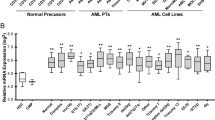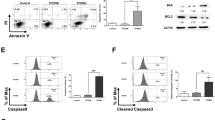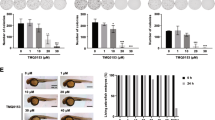Abstract
High concentrations (greater than 5 μ M) of arsenic trioxide (As2O3) have been reported to be able to induce apoptosis in several malignant cells. We explored cell lines in which apoptosis was induced with a therapeutic concentration (1–2 μ M) of As2O3, and found that 1 μ M of As2O3 induced apoptosis in the NKM-1 cell line, which was established from a patient with acute myeloid leukemia (M2). Apoptosis induced by 1 μ M of As2O3 in NKM-1 cells was accompanied by an increased cellular content of H2O2, a decreased mitochondrial membrane potential (Δψm), and activation of caspase-3. C-Jun-terminal kinase (JNK) was activated only in NKM-1 cells and arsenic-sensitive NB4 cells, but not in arsenic-insensitive HL-60 cells. Activation of JNK in NKM-1 was sustained from 6 to 24 h after As2O3 treatment, and preceded changes in cellular H2O2, Δψm, and caspase-3 activation. Moreover, addition of a JNK inhibitor reduced the percentage of apoptotic cells after the As2O3 treatment. Taken together, in the M2 cell line NKM-1, 1 μ M of As2O3 induced sustained activation of JNK and apoptosis. This finding may provide a basis to select a subgroup other than acute promyelocytic leukemia, which can benefit from As2O3 treatment.
This is a preview of subscription content, access via your institution
Access options
Subscribe to this journal
Receive 12 print issues and online access
$259.00 per year
only $21.58 per issue
Buy this article
- Purchase on Springer Link
- Instant access to full article PDF
Prices may be subject to local taxes which are calculated during checkout





Similar content being viewed by others
References
Agis H, Weltermann A, Mitterbauer G, Thalhammer R, Edelhauser M, Seewann HL et al. Successful treatment with arsenic trioxide of a patient with ATRA-resistant relapse of acute promyelocytic leukemia. Ann Hematol 1999; 78: 329–332.
Chen GQ, Shi XG, Tang W, Xiong SM, Zhu J, Cai X et al. Use of arsenic trioxide (As2O3) in the treatment of acute promyelocytic leukemia (APL): I. As2O3 exerts dose-dependent dual effects on APL cells. Blood 1997; 89: 3345–3353.
Shen ZX, Chen GQ, Ni JH, Li XS, Xiong SM, Qiu QY et al. Use of arsenic trioxide (As2O3) in the treatment of acute promyelocytic leukemia (APL): II. Clinical efficacy and pharmacokinetics in relapsed patients. Blood 1997; 89: 3354–3360.
Soignet SL, Maslak P, Wang ZG, Jhanwar S, Calleja E, Dardashti LJ et al. Complete remission after treatment of acute promyelocytic leukemia with arsenic trioxide. N Engl J Med 1998; 339: 1341–1348.
Soignet SL, Frankel SR, Douer D, Tallman MS, Kantarjian H, Calleja E et al. United States multicenter study of arsenic trioxide in relapsed acute promyelocytic leukemia. J Clin Oncol 2001; 19: 3852–3860.
Akao Y, Nakagawa Y, Akiyama K . Arsenic trioxide induces apoptosis in neuroblastoma cell lines through the activation of caspase 3 in vitro. FEBS Lett 1999; 455: 59–62.
Akao Y, Mizoguchi H, Kojima S, Naoe T, Ohishi N, Yagi K . Arsenic induces apoptosis in B-cell leukaemic cell lines in vitro: activation of caspases and down-regulation of Bcl-2 protein. Br J Haematol 1998; 102: 1055–1060.
Lu M, Levin J, Sulpice E, Sequeira-Le Grand A, Alemany M, Caen JP et al. Effect of arsenic trioxide on viability, proliferation, and apoptosis in human megakaryocytic leukemia cell lines. Exp Hematol 1999; 27: 845–852.
Maeda H, Hori S, Nishitoh H, Ichijo H, Ogawa O, Kakehi Y et al. Tumor growth inhibition by arsenic trioxide (As2O3) in the orthotopic metastasis model of androgen-independent prostate cancer. Cancer Res 2001; 61: 5432–5440.
Rousselot P, Labaume S, Marolleau JP, Larghero J, Noguera MH, Brouet JC et al. Arsenic trioxide and melarsoprol induce apoptosis in plasma cell lines and in plasma cells from myeloma patients. Cancer Res 1999; 59: 1041–1048.
Zhang W, Ohnishi K, Shigeno K, Fujisawa S, Naito K, Nakamura S et al. The induction of apoptosis and cell cycle arrest by arsenic trioxide in lymphoid neoplasms. Leukemia 1998; 12: 1383–1391.
Zheng J, Deng YP, Lin C, Fu M, Xiao PG, Wu M . Arsenic trioxide induces apoptosis of HPV16 DNA-immortalized human cervical epithelial cells and selectively inhibits viral gene expression. Int J Cancer 1999; 82: 286–292.
Zhu XH, Shen YL, Jing YK, Cai X, Jia PM, Huang Y et al. Apoptosis and growth inhibition in malignant lymphocytes after treatment with arsenic trioxide at clinically achievable concentrations. J Natl Cancer Inst 1999; 91: 772–778.
Miller Jr WH, Schipper HM, Lee JS, Singer J, Waxman S . Mechanisms of action of arsenic trioxide. Cancer Res 2002; 62: 3893–3903.
Baynes JW . Role of oxidative stress in development of complications in diabetes. Diabetes 1991; 40: 405–412.
Halliwell B, Gutteridge JM, Cross CE . Free radicals, antioxidants, and human disease: where are we now? J Lab Clin Med 1992; 119: 598–620.
Chen YC, Lin-Shiau SY, Lin JK . Involvement of reactive oxygen species and caspase 3 activation in arsenite-induced apoptosis. J Cell Physiol 1998; 177: 324–333.
Dai J, Weinberg RS, Waxman S, Jing Y . Malignant cells can be sensitized to undergo growth inhibition and apoptosis by arsenic trioxide through modulation of the glutathione redox system. Blood 1999; 93: 268–277.
Jing Y, Dai J, Chalmers-Redman RM, Tatton WG, Waxman S . Arsenic trioxide selectively induces acute promyelocytic leukemia cell apoptosis via a hydrogen peroxide-dependent pathway. Blood 1999; 94: 2102–2111.
Cantoni O, Hussain S, Guidarelli A, Cattabeni F . Cross-resistance to heavy metals in hydrogen peroxide-resistant CHO cell variants. Mutat Res 1994; 324: 1–6.
Wang TS, Kuo CF, Jan KY, Huang H . Arsenite induces apoptosis in Chinese hamster ovary cells by generation of reactive oxygen species. J Cell Physiol 1996; 169: 256–268.
Nishida E, Gotoh Y . The MAP kinase cascade is essential for diverse signal transduction pathways. Trends Biochem Sci 1993; 18: 128–131.
Widmann C, Gibson S, Jarpe MB, Johnson GL . Mitogen-activated protein kinase: conservation of a three-kinase module from yeast to human. Physiol Rev 1999; 79: 143–180.
Xia Z, Dickens M, Raingeaud J, Davis RJ, Greenberg ME . Opposing effects of ERK and JNK-p38 MAP kinases on apoptosis. Science 1995; 270: 1326–1331.
Kyriakis JM, Avruch J . Protein kinase cascades activated by stress and inflammatory cytokines. Bioessays 1996; 18: 567–577.
Ichijo H . From receptors to stress-activated MAP kinases. Oncogene 1999; 18: 6087–6093.
Kataoka T, Morishita Y, Ogura M, Morishima Y, Towatari M, Kato Y et al. A novel human myeloid leukemia cell line, NKM-1, coexpressing granulocyte colony-stimulating factor receptors and macrophage colony-stimulating factor receptors. Cancer Res 1990; 50: 7703–7709.
Quillet-Mary A, Jaffrezou JP, Mansat V, Bordier C, Naval J, Laurent G . Implication of mitochondrial hydrogen peroxide generation in ceramide-induced apoptosis. J Biol Chem 1997; 272: 21388–21395.
Hockenbery DM, Oltvai ZN, Yin XM, Milliman CL, Korsmeyer SJ . Bcl-2 functions in an antioxidant pathway to prevent apoptosis. Cell 1993; 75: 241–251.
Zamzami N, Marchetti P, Castedo M, Decaudin D, Macho A, Hirsch T et al. Sequential reduction of mitochondrial transmembrane potential and generation of reactive oxygen species in early programmed cell death. J Exp Med 1995; 182: 367–377.
Vandeputte C, Guizon I, Genestie-Denis I, Vannier B, Lorenzon G . A microtiter plate assay for total glutathione and glutathione disulfide contents in cultured/isolated cells: performance study of a new miniaturized protocol. Cell Biol Toxicol 1994; 10: 415–421.
Cai X, Shen YL, Zhu Q, Jia PM, Yu Y, Zhou L et al. Arsenic trioxide-induced apoptosis and differentiation are associated respectively with mitochondrial transmembrane potential collapse and retinoic acid signaling pathways in acute promyelocytic leukemia. Leukemia 2000; 14: 262–270.
Hossain K, Akhand AA, Kato M, Du J, Takeda K, Wu J et al. Arsenite induces apoptosis of murine T lymphocytes through membrane raft-linked signaling for activation of c-Jun amino-terminal kinase. J Immunol 2000; 165: 4290–4297.
Kitamura K, Minami Y, Yamamoto K, Akao Y, Kiyoi H, Saito H et al. Involvement of CD95-independent caspase 8 activation in arsenic trioxide-induced apoptosis. Leukemia 2000; 14: 1743–1750.
Zamzami N, Marchetti P, Castedo M, Zanin C, Vayssiere JL, Petit PX et al. Reduction in mitochondrial potential constitutes an early irreversible step of programmed lymphocyte death in vivo. J Exp Med 1995; 181: 1661–1672.
Lee TC, Wei ML, Chang WJ, Ho IC, Lo JF, Jan KY et al. Elevation of glutathione levels and glutathione S-transferase activity in arsenic-resistant Chinese hamster ovary cells. In Vitro Cell Dev Biol 1989; 25: 442–448.
Lo JF, Wang HF, Tam MF, Lee TC . Glutathione S-transferase pi in an arsenic-resistant Chinese hamster ovary cell line. Biochem J 1992; 288: 977–982.
Yang CH, Kuo ML, Chen JC, Chen YC . Arsenic trioxide sensitivity is associated with low level of glutathione in cancer cells. Br J Cancer 1999; 81: 796–799.
Grad JM, Bahlis NJ, Reis I, Oshiro MM, Dalton WS, Boise LH . Ascorbic acid enhances arsenic trioxide-induced cytotoxicity in multiple myeloma cells. Blood 2001; 98: 805–813.
Iwama K, Nakajo S, Aiuchi T, Nakaya K . Apoptosis induced by arsenic trioxide in leukemia U937 cells is dependent on activation of p38, inactivation of ERK and the Ca2+-dependent production of superoxide. Int J Cancer 2001; 92: 518–526.
Meister A . Glutathione, ascorbate, and cellular protection. Cancer Res 1994; 54: 1969s–1975s.
Zhang K, Mack P, Wong KP . Glutathione-related mechanisms in cellular resistance to anticancer drugs. Int J Oncol 1998; 12: 871–882.
Cavigelli M, Li WW, Lin A, Su B, Yoshioka K, Karin M . The tumor promoter arsenite stimulates AP-1 activity by inhibiting a JNK phosphatase. EMBO J 1996; 15: 6269–6279.
Lim CP, Jain N, Cao X . Stress-induced immediate-early gene, egr-1, involves activation of p38/JNK1. Oncogene 1998; 16: 2915–2926.
Kawasaki H, Moriguchi T, Matsuda S, Li HZ, Nakamura S, Shimohama S et al. Ras-dependent and Ras-independent activation pathways for the stress-activated-protein-kinase cascade. Eur J Biochem 1996; 241: 315–321.
Huang C, Ma WY, Li J, Goranson A, Dong Z . Requirement of Erk, but not JNK, for arsenite-induced cell transformation. J Biol Chem 1999; 274: 14595–14601.
Tobiume K, Matsuzawa A, Takahashi T, Nishitoh H, Morita K, Takeda K et al. ASK1 is required for sustained activations of JNK/p38 MAP kinases and apoptosis. EMBO Rep 2001; 2: 222–228.
Theodosiou A, Ashworth A . Differential effects of stress stimuli on a JNK-inactivating phosphatase. Oncogene 2002; 21: 2387–2397.
Saitoh M, Nishitoh H, Fujii M, Takeda K, Tobiume K, Sawada Y et al. Mammalian thioredoxin is a direct inhibitor of apoptosis signal-regulating kinase (ASK) 1. EMBO J 1998; 17: 2596–2606.
Acknowledgements
We thank Satoshi Suzuki and Chika Wakamatsu for their excellent technical assistance.
Author information
Authors and Affiliations
Rights and permissions
About this article
Cite this article
Kajiguchi, T., Yamamoto, K., Hossain, K. et al. Sustained activation of c-jun-terminal kinase (JNK) is closely related to arsenic trioxide-induced apoptosis in an acute myeloid leukemia (M2)-derived cell line, NKM-1. Leukemia 17, 2189–2195 (2003). https://doi.org/10.1038/sj.leu.2403120
Received:
Accepted:
Published:
Issue Date:
DOI: https://doi.org/10.1038/sj.leu.2403120
Keywords
This article is cited by
-
Arsenic hexoxide has differential effects on cell proliferation and genome-wide gene expression in human primary mammary epithelial and MCF7 cells
Scientific Reports (2021)
-
Arsenic trioxide induces apoptosis and the formation of reactive oxygen species in rat glioma cells
Cellular & Molecular Biology Letters (2018)
-
The roles of mitoferrin-2 in the process of arsenic trioxide-induced cell damage in human gliomas
European Journal of Medical Research (2014)
-
Assessment of the involvement of oxidative stress and Mitogen-Activated Protein Kinase signaling pathways in the cytotoxic effects of arsenic trioxide and its combination with sulindac or its metabolites: sulindac sulfide and sulindac sulfone on human leukemic cell lines
Medical Oncology (2012)
-
Mitogen-activated protein kinases mediate arsenic-induced down-regulation of survivin in human lung adenocarcinoma cells
Archives of Toxicology (2006)



